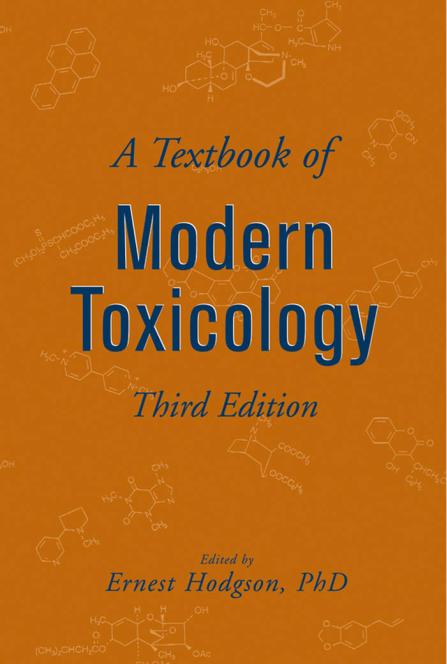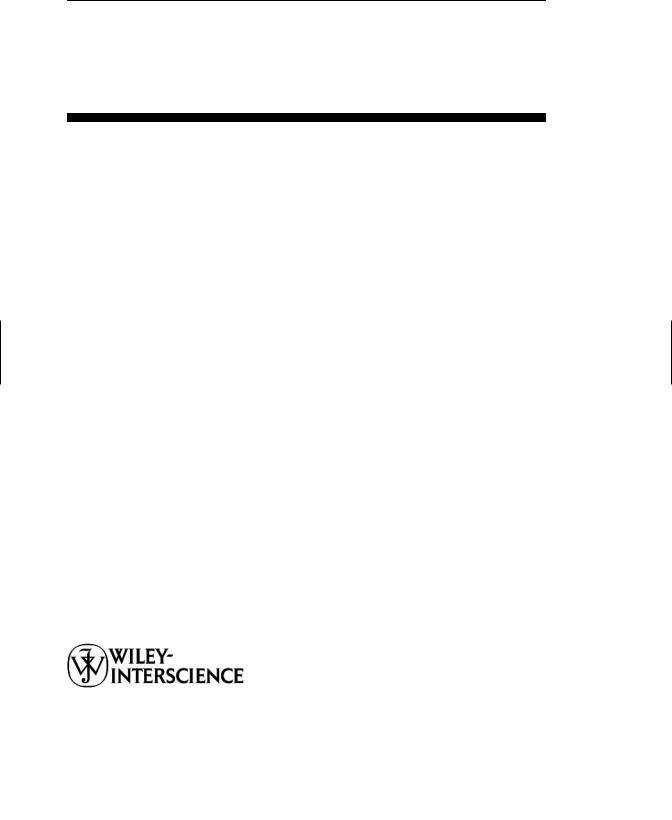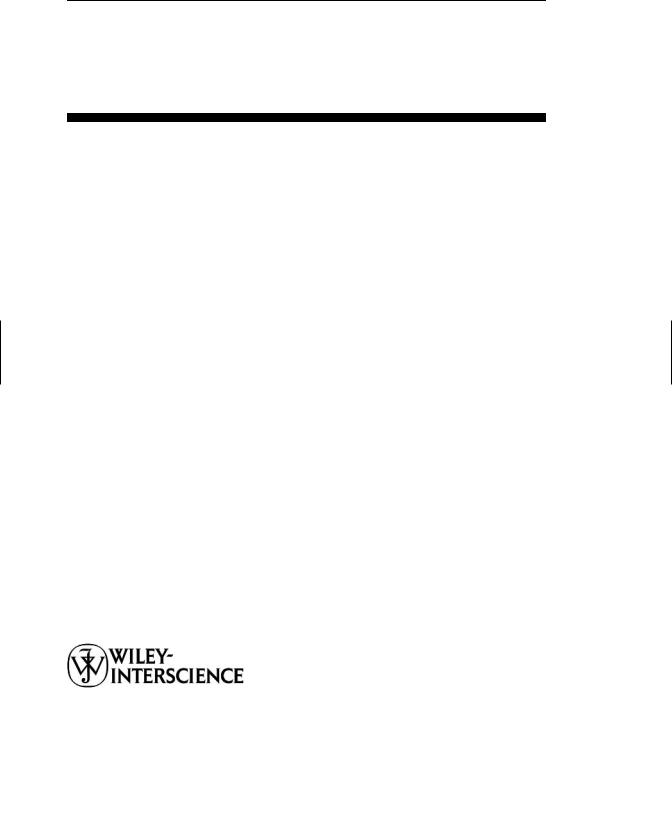
- •CONTENTS
- •Preface
- •Contributors
- •1 Introduction to Toxicology
- •1.1 Definition and Scope, Relationship to Other Sciences, and History
- •1.1.2 Relationship to Other Sciences
- •1.1.3 A Brief History of Toxicology
- •1.3 Sources of Toxic Compounds
- •1.3.1 Exposure Classes
- •1.3.2 Use Classes
- •1.4 Movement of Toxicants in the Environment
- •Suggested Reading
- •2.1 Introduction
- •2.2 Cell Culture Techniques
- •2.2.1 Suspension Cell Culture
- •2.2.2 Monolayer Cell Culture
- •2.2.3 Indicators of Toxicity in Cultured Cells
- •2.3 Molecular Techniques
- •2.3.1 Molecular Cloning
- •2.3.2 cDNA and Genomic Libraries
- •2.3.3 Northern and Southern Blot Analyses
- •2.3.4 Polymerase Chain Reaction (PCR)
- •2.3.5 Evaluation of Gene Expression, Regulation, and Function
- •2.4 Immunochemical Techniques
- •Suggested Reading
- •3.1 Introduction
- •3.2 General Policies Related to Analytical Laboratories
- •3.2.1 Standard Operating Procedures (SOPs)
- •3.2.2 QA/QC Manuals
- •3.2.3 Procedural Manuals
- •3.2.4 Analytical Methods Files
- •3.2.5 Laboratory Information Management System (LIMS)
- •3.3 Analytical Measurement System
- •3.3.1 Analytical Instrument Calibration
- •3.3.2 Quantitation Approaches and Techniques
- •3.4 Quality Assurance (QA) Procedures
- •3.5 Quality Control (QC) Procedures
- •3.6 Summary
- •Suggested Reading
- •4 Exposure Classes, Toxicants in Air, Water, Soil, Domestic and Occupational Settings
- •4.1 Air Pollutants
- •4.1.1 History
- •4.1.2 Types of Air Pollutants
- •4.1.3 Sources of Air Pollutants
- •4.1.4 Examples of Air Pollutants
- •4.1.5 Environmental Effects
- •4.2 Water and Soil Pollutants
- •4.2.1 Sources of Water and Soil Pollutants
- •4.2.2 Examples of Pollutants
- •4.3 Occupational Toxicants
- •4.3.1 Regulation of Exposure Levels
- •4.3.2 Routes of Exposure
- •4.3.3 Examples of Industrial Toxicants
- •Suggested Reading
- •5 Classes of Toxicants: Use Classes
- •5.1 Introduction
- •5.2 Metals
- •5.2.1 History
- •5.2.2 Common Toxic Mechanisms and Sites of Action
- •5.2.3 Lead
- •5.2.4 Mercury
- •5.2.5 Cadmium
- •5.2.6 Chromium
- •5.2.7 Arsenic
- •5.2.8 Treatment of Metal Poisoning
- •5.3 Agricultural Chemicals (Pesticides)
- •5.3.1 Introduction
- •5.3.3 Organochlorine Insecticides
- •5.3.4 Organophosphorus Insecticides
- •5.3.5 Carbamate Insecticides
- •5.3.6 Botanical Insecticides
- •5.3.7 Pyrethroid Insecticides
- •5.3.8 New Insecticide Classes
- •5.3.9 Herbicides
- •5.3.10 Fungicides
- •5.3.11 Rodenticides
- •5.3.12 Fumigants
- •5.3.13 Conclusions
- •5.4 Food Additives and Contaminants
- •5.5 Toxins
- •5.5.1 History
- •5.5.2 Microbial Toxins
- •5.5.3 Mycotoxins
- •5.5.4 Algal Toxins
- •5.5.5 Plant Toxins
- •5.5.6 Animal Toxins
- •5.6 Solvents
- •5.7 Therapeutic Drugs
- •5.8 Drugs of Abuse
- •5.9 Combustion Products
- •5.10 Cosmetics
- •Suggested Reading
- •6 Absorption and Distribution of Toxicants
- •6.1 Introduction
- •6.2 Cell Membranes
- •6.3 Mechanisms of Transport
- •6.3.1 Passive Diffusion
- •6.4 Physicochemical Properties Relevant to Diffusion
- •6.4.1 Ionization
- •6.5 Routes of Absorption
- •6.5.1 Extent of Absorption
- •6.5.2 Gastrointestinal Absorption
- •6.5.3 Dermal Absorption
- •6.5.4 Respiratory Penetration
- •6.6 Toxicant Distribution
- •6.6.1 Physicochemical Properties and Protein Binding
- •6.7 Toxicokinetics
- •Suggested Reading
- •7 Metabolism of Toxicants
- •7.1 Introduction
- •7.2 Phase I Reactions
- •7.2.4 Nonmicrosomal Oxidations
- •7.2.5 Cooxidation by Cyclooxygenases
- •7.2.6 Reduction Reactions
- •7.2.7 Hydrolysis
- •7.2.8 Epoxide Hydration
- •7.2.9 DDT Dehydrochlorinase
- •7.3 Phase II Reactions
- •7.3.1 Glucuronide Conjugation
- •7.3.2 Glucoside Conjugation
- •7.3.3 Sulfate Conjugation
- •7.3.4 Methyltransferases
- •7.3.7 Acylation
- •7.3.8 Phosphate Conjugation
- •Suggested Reading
- •8 Reactive Metabolites
- •8.1 Introduction
- •8.2 Activation Enzymes
- •8.3 Nature and Stability of Reactive Metabolites
- •8.4 Fate of Reactive Metabolites
- •8.4.1 Binding to Cellular Macromolecules
- •8.4.2 Lipid Peroxidation
- •8.4.3 Trapping and Removal: Role of Glutathione
- •8.5 Factors Affecting Toxicity of Reactive Metabolites
- •8.5.1 Levels of Activating Enzymes
- •8.5.2 Levels of Conjugating Enzymes
- •8.5.3 Levels of Cofactors or Conjugating Chemicals
- •8.6 Examples of Activating Reactions
- •8.6.1 Parathion
- •8.6.2 Vinyl Chloride
- •8.6.3 Methanol
- •8.6.5 Carbon Tetrachloride
- •8.6.8 Acetaminophen
- •8.6.9 Cycasin
- •8.7 Future Developments
- •Suggested Reading
- •9.1 Introduction
- •9.2 Nutritional Effects
- •9.2.1 Protein
- •9.2.2 Carbohydrates
- •9.2.3 Lipids
- •9.2.4 Micronutrients
- •9.2.5 Starvation and Dehydration
- •9.2.6 Nutritional Requirements in Xenobiotic Metabolism
- •9.3 Physiological Effects
- •9.3.1 Development
- •9.3.2 Gender Differences
- •9.3.3 Hormones
- •9.3.4 Pregnancy
- •9.3.5 Disease
- •9.3.6 Diurnal Rhythms
- •9.4 Comparative and Genetic Effects
- •9.4.1 Variations Among Taxonomic Groups
- •9.4.2 Selectivity
- •9.4.3 Genetic Differences
- •9.5 Chemical Effects
- •9.5.1 Inhibition
- •9.5.2 Induction
- •9.5.3 Biphasic Effects: Inhibition and Induction
- •9.6 Environmental Effects
- •9.7 General Summary and Conclusions
- •Suggested Reading
- •10 Elimination of Toxicants
- •10.1 Introduction
- •10.2 Transport
- •10.3 Renal Elimination
- •10.4 Hepatic Elimination
- •10.4.2 Active Transporters of the Bile Canaliculus
- •10.5 Respiratory Elimination
- •10.6 Conclusion
- •Suggested Reading
- •11 Acute Toxicity
- •11.1 Introduction
- •11.2 Acute Exposure and Effect
- •11.3 Dose-response Relationships
- •11.4 Nonconventional Dose-response Relationships
- •11.5 Mechanisms of Acute Toxicity
- •11.5.1 Narcosis
- •11.5.2 Acetylcholinesterase Inhibition
- •11.5.3 Ion Channel Modulators
- •11.5.4 Inhibitors of Cellular Respiration
- •Suggested Reading
- •12 Chemical Carcinogenesis
- •12.1 General Aspects of Cancer
- •12.2 Human Cancer
- •12.2.1 Causes, Incidence, and Mortality Rates of Human Cancer
- •12.2.2 Known Human Carcinogens
- •12.3 Classes of Agents Associated with Carcinogenesis
- •12.3.2 Epigenetic Agents
- •12.4 General Aspects of Chemical Carcinogenesis
- •12.5 Initiation-Promotion Model for Chemical Carcinogenesis
- •12.6 Metabolic Activation of Chemical Carcinogens and DNA Adduct Formation
- •12.7 Oncogenes
- •12.8 Tumor Suppressor Genes
- •12.8.1 Inactivation of Tumor Suppressor Genes
- •12.8.2 p53 Tumor Suppressor Gene
- •12.9 General Aspects of Mutagenicity
- •12.10 Usefulness and Limitations of Mutagenicity Assays for the Identification of Carcinogens
- •Suggested Reading
- •13 Teratogenesis
- •13.1 Introduction
- •13.2 Principles of Teratology
- •13.3 Mammalian Embryology Overview
- •13.4 Critical Periods
- •13.5 Historical Teratogens
- •13.5.1 Thalidomide
- •13.5.2 Accutane (Isotetrinoin)
- •13.5.3 Diethylstilbestrol (DES)
- •13.5.4 Alcohol
- •13.6 Testing Protocols
- •13.6.1 FDA Guidelines for Reproduction Studies for Safety Evaluation of Drugs for Human Use
- •13.6.3 Alternative Test Methods
- •13.7 Conclusions
- •Suggested Reading
- •14 Hepatotoxicity
- •14.1 Introduction
- •14.1.1 Liver Structure
- •14.1.2 Liver Function
- •14.2 Susceptibility of the Liver
- •14.3 Types of Liver Injury
- •14.3.1 Fatty Liver
- •14.3.2 Necrosis
- •14.3.3 Apoptosis
- •14.3.4 Cholestasis
- •14.3.5 Cirrhosis
- •14.3.6 Hepatitis
- •14.3.7 Oxidative Stress
- •14.3.8 Carcinogenesis
- •14.4 Mechanisms of Hepatotoxicity
- •14.5 Examples of Hepatotoxicants
- •14.5.1 Carbon Tetrachloride
- •14.5.2 Ethanol
- •14.5.3 Bromobenzene
- •14.5.4 Acetaminophen
- •14.6 Metabolic Activation of Hepatotoxicants
- •Suggested Reading
- •15 Nephrotoxicity
- •15.1 Introduction
- •15.1.1 Structure of the Renal System
- •15.1.2 Function of the Renal System
- •15.2 Susceptibility of the Renal System
- •15.3 Examples of Nephrotoxicants
- •15.3.1 Metals
- •15.3.2 Aminoglycosides
- •15.3.3 Amphotericin B
- •15.3.4 Chloroform
- •15.3.5 Hexachlorobutadiene
- •Suggested Reading
- •16 Toxicology of the Nervous System
- •16.1 Introduction
- •16.2 The Nervous system
- •16.2.1 The Neuron
- •16.2.2 Neurotransmitters and their Receptors
- •16.2.3 Glial Cells
- •16.3 Toxicant Effects on the Nervous System
- •16.3.1 Structural Effects of Toxicants on Neurons
- •16.3.2 Effects of Toxicants on Other Cells
- •16.4 Neurotoxicity Testing
- •16.4.1 In vivo Tests of Human Exposure
- •16.4.2 In vivo Tests of Animal Exposure
- •16.4.3 In vitro Neurochemical and Histopathological End Points
- •16.5 Summary
- •Suggested Reading
- •17 Endocrine System
- •17.1 Introduction
- •17.2 Endocrine System
- •17.2.1 Nuclear Receptors
- •17.3 Endocrine Disruption
- •17.3.1 Hormone Receptor Agonists
- •17.3.2 Hormone Receptor Antagonists
- •17.3.3 Organizational versus Activational Effects of Endocrine Toxicants
- •17.3.4 Inhibitors of Hormone Synthesis
- •17.3.5 Inducers of Hormone Clearance
- •17.3.6 Hormone Displacement from Binding Proteins
- •17.4 Incidents of Endocrine Toxicity
- •17.4.1 Organizational Toxicity
- •17.4.2 Activational Toxicity
- •17.4.3 Hypothyroidism
- •17.5 Conclusion
- •Suggested Reading
- •18 Respiratory Toxicity
- •18.1 Introduction
- •18.1.1 Anatomy
- •18.1.2 Cell Types
- •18.1.3 Function
- •18.2 Susceptibility of the Respiratory System
- •18.2.1 Nasal
- •18.2.2 Lung
- •18.3 Types of Toxic Response
- •18.3.1 Irritation
- •18.3.2 Cell Necrosis
- •18.3.3 Fibrosis
- •18.3.4 Emphysema
- •18.3.5 Allergic Responses
- •18.3.6 Cancer
- •18.3.7 Mediators of Toxic Responses
- •18.4 Examples of Lung Toxicants Requiring Activation
- •18.4.1 Introduction
- •18.4.2 Monocrotaline
- •18.4.3 Ipomeanol
- •18.4.4 Paraquat
- •18.5 Defense Mechanisms
- •Suggested Reading
- •19 Immunotoxicity
- •19.1 Introduction
- •19.2 The Immune System
- •19.3 Immune Suppression
- •19.4 Classification of Immune-Mediated Injury (Hypersensitivity)
- •19.5 Effects of Chemicals on Allergic Disease
- •19.5.1 Allergic Contact Dermatitis
- •19.5.2 Respiratory Allergens
- •19.5.3 Adjuvants
- •19.6 Emerging Issues: Food Allergies, Autoimmunity, and the Developing Immune System
- •Suggested Reading
- •20 Reproductive System
- •20.1 Introduction
- •20.2 Male Reproductive Physiology
- •20.3 Mechanisms and Targets of Male Reproductive Toxicants
- •20.3.1 General Mechanisms
- •20.3.2 Effects on Germ Cells
- •20.3.3 Effects on Spermatogenesis and Sperm Quality
- •20.3.4 Effects on Sexual Behavior
- •20.3.5 Effects on Endocrine Function
- •20.4 Female Reproductive Physiology
- •20.5 Mechanisms and Targets of Female Reproductive Toxicants
- •20.5.1 Tranquilizers, Narcotics, and Social Drugs
- •20.5.2 Endocrine Disruptors (EDs)
- •20.5.3 Effects on Germ Cells
- •20.5.4 Effects on the Ovaries and Uterus
- •20.5.5 Effects on Sexual Behavior
- •Suggested Reading
- •21 Toxicity Testing
- •21.1 Introduction
- •21.2 Experimental Administration of Toxicants
- •21.2.1 Introduction
- •21.2.2 Routes of Administration
- •21.3 Chemical and Physical Properties
- •21.4 Exposure and Environmental Fate
- •21.5 In vivo Tests
- •21.5.1 Acute and Subchronic Toxicity Tests
- •21.5.2 Chronic Tests
- •21.5.3 Reproductive Toxicity and Teratogenicity
- •21.5.4 Special Tests
- •21.6 In vitro and Other Short-Term Tests
- •21.6.1 Introduction
- •21.6.2 Prokaryote Mutagenicity
- •21.6.3 Eukaryote Mutagenicity
- •21.6.4 DNA Damage and Repair
- •21.6.5 Chromosome Aberrations
- •21.6.6 Mammalian Cell Transformation
- •21.6.7 General Considerations and Testing Sequences
- •21.7 Ecological Effects
- •21.7.1 Laboratory Tests
- •21.7.2 Simulated Field Tests
- •21.7.3 Field Tests
- •21.8 Risk Analysis
- •21.9 The Future of Toxicity Testing
- •Suggested Reading
- •22 Forensic and Clinical Toxicology
- •22.1 Introduction
- •22.2 Foundations of Forensic Toxicology
- •22.3 Courtroom Testimony
- •22.4.1 Documentation Practices
- •22.4.2 Considerations for Forensic Toxicological Analysis
- •22.4.3 Drug Concentrations and Distribution
- •22.5 Laboratory Analyses
- •22.5.1 Colorimetric Screening Tests
- •22.5.2 Thermal Desorption
- •22.5.6 Enzymatic Immunoassay
- •22.6 Analytical Schemes for Toxicant Detection
- •22.7 Clinical Toxicology
- •22.7.1 History Taking
- •22.7.2 Basic Operating Rules in the Treatment of Toxicosis
- •22.7.3 Approaches to Selected Toxicoses
- •Suggested Reading
- •23 Prevention of Toxicity
- •23.1 Introduction
- •23.2 Legislation and Regulation
- •23.2.1 Federal Government
- •23.2.2 State Governments
- •23.2.3 Legislation and Regulation in Other Countries
- •23.3 Prevention in Different Environments
- •23.3.1 Home
- •23.3.2 Workplace
- •23.3.3 Pollution of Air, Water, and Land
- •23.4 Education
- •Suggested Reading
- •24 Human Health Risk Assessment
- •24.1 Introduction
- •24.2 Risk Assessment Methods
- •24.2.2 Exposure Assessment
- •24.2.3 Dose Response and Risk Characterization
- •24.3 Noncancer Risk Assessment
- •24.3.1 Default Uncertainty and Modifying Factors
- •24.3.2 Derivation of Developmental Toxicant RfD
- •24.3.3 Determination of RfD and RfC of Naphthalene with the NOAEL Approach
- •24.3.4 Benchmark Dose Approach
- •24.3.5 Determination of BMD and BMDL for ETU
- •24.3.6 Quantifying Risk for Noncarcinogenic Effects: Hazard Quotient
- •24.3.7 Chemical Mixtures
- •24.4 Cancer Risk Assessment
- •24.5 PBPK Modeling
- •Suggested Reading
- •25 Analytical Methods in Toxicology
- •25.1 Introduction
- •25.2 Chemical and Physical Methods
- •25.2.1 Sampling
- •25.2.2 Experimental Studies
- •25.2.3 Forensic Studies
- •25.2.4 Sample Preparation
- •25.2.6 Spectroscopy
- •25.2.7 Other Analytical Methods
- •Suggested Reading
- •26 Basics of Environmental Toxicology
- •26.1 Introduction
- •26.2 Environmental Persistence
- •26.2.1 Abiotic Degradation
- •26.2.2 Biotic Degradation
- •26.2.3 Nondegradative Elimination Processes
- •26.3 Bioaccumulation
- •26.4 Toxicity
- •26.4.1 Acute Toxicity
- •26.4.2 Mechanisms of Acute Toxicity
- •26.4.3 Chronic Toxicity
- •26.4.5 Abiotic and Biotic Interactions
- •26.5 Conclusion
- •Suggested Reading
- •27.1 Introduction
- •27.2 Sources of Toxicants to the Environment
- •27.3 Transport Processes
- •27.3.1 Advection
- •27.3.2 Diffusion
- •27.4 Equilibrium Partitioning
- •27.5 Transformation Processes
- •27.5.1 Reversible Reactions
- •27.5.2 Irreversible Reactions
- •27.6 Environmental Fate Models
- •Suggested Reading
- •28 Environmental Risk Assessment
- •28.1 Introduction
- •28.2 Formulating the Problem
- •28.2.1 Selecting Assessment End Points
- •28.2.2 Developing Conceptual Models
- •28.2.3 Selecting Measures
- •28.3 Analyzing Exposure and Effects Information
- •28.3.1 Characterizing Exposure
- •28.3.2 Characterizing Ecological Effects
- •28.4 Characterizing Risk
- •28.4.1 Estimating Risk
- •28.4.2 Describing Risk
- •28.5 Managing Risk
- •Suggested Reading
- •29 Future Considerations for Environmental and Human Health
- •29.1 Introduction
- •29.2 Risk Management
- •29.3 Risk Assessment
- •29.4 Hazard and Exposure Assessment
- •29.5 In vivo Toxicity
- •29.6 In vitro Toxicity
- •29.7 Biochemical and Molecular Toxicology
- •29.8 Development of Selective Toxicants
- •Glossary
- •Index


A TEXTBOOK OF MODERN TOXICOLOGY
THIRD EDITION
Edited by
Ernest Hodgson
Department of Environmental
and Biochemical Toxicology
North Carolina State University
A JOHN WILEY & SONS, INC., PUBLICATION


A TEXTBOOK OF MODERN TOXICOLOGY
THIRD EDITION


A TEXTBOOK OF MODERN TOXICOLOGY
THIRD EDITION
Edited by
Ernest Hodgson
Department of Environmental
and Biochemical Toxicology
North Carolina State University
A JOHN WILEY & SONS, INC., PUBLICATION

Copyright 2004 by John Wiley & Sons, Inc. All rights reserved.
Published by John Wiley & Sons, Inc., Hoboken, New Jersey.
Published simultaneously in Canada.
No part of this publication may be reproduced, stored in a retrieval system, or transmitted in any form or by any means, electronic, mechanical, photocopying, recording, scanning, or otherwise, except as permitted under Section 107 or 108 of the 1976 United States Copyright Act, without either the prior written permission of the Publisher, or authorization through payment of the appropriate per-copy fee to the Copyright Clearance Center, Inc., 222 Rosewood Drive, Danvers,
MA 01923, 978-750-8400, fax 978-646-8600, or on theat wwwweb.copyright.com. Requests to the Publisher for permission should be addressed to the Permissions Department, John Wiley & Sons,
Inc., 111 River Street, Hoboken, NJ 07030, (201) 748-6011, fax (201) 748-6008.
Limit of Liability/Disclaimer of Warranty: While the publisher and author have used their best efforts in preparing this book, they make no representations or warranties with respect to the accuracy or completeness of the contents of this book and specifically disclaim any implied warranties of merchantability or fitness for a particular purpose. No warranty may be created or extended by sales representatives or written sales materials. The advice and strategies contained herein may not be suitable for your situation. You should consult with a professional where appropriate. Neither the publisher nor author shall be liable for any loss of profit or any other commercial damages, including but not limited to special, incidental, consequential, or other damages.
For general information on our other products and services please contact our Customer Care Department within the U.S. at 877-762-2974, outside the U.S. at 317-572-3993 or fax 317-572-4002.
Wiley also publishes its books in a variety of electronic formats. Some content that appears in print, however, may not be available in electronic format.
Library of Congress Cataloging-in-Publication Data:
Hodgson, Ernest, 1932–
A textbook of modern toxicology / Ernest Hodgson.—3rd ed.
p.cm.
Includes bibliographical references and index. ISBN 0-471-26508-X
1. Toxicology. I. Title.
RA1211.H62 2004 |
|
615.9—dc22 |
2003017524 |
Printed in the United States of America.
10 9 8 7 6 5 4 3 2 1

 CONTENTS
CONTENTS
Preface |
|
|
xix |
|
Contributors |
|
xxi |
||
I |
Introduction |
|
1 |
|
1 |
Introduction to Toxicology |
3 |
||
|
Ernest Hodgson |
|
||
|
1.1 |
Definition and Scope, Relationship to Other Sciences, and History |
3 |
|
|
|
1.1.1 |
Definition and Scope |
3 |
|
|
1.1.2 Relationship to Other Sciences |
8 |
|
|
|
1.1.3 A Brief History of Toxicology |
8 |
|
|
1.2 |
Dose-Response Relationships |
10 |
|
|
1.3 |
Sources of Toxic Compounds |
10 |
|
|
|
1.3.1 |
Exposure Classes |
11 |
|
|
1.3.2 |
Use Classes |
11 |
|
1.4 |
Movement of Toxicants in the Environment |
11 |
|
|
|
Suggested Reading |
12 |
|
2 |
Introduction to Biochemical and Molecular Methods in Toxicology |
13 |
||
|
Ernest Hodgson, Gerald A. LeBlanc, Sharon A. Meyer, and Robert C. Smart |
|
||
|
2.1 |
Introduction |
13 |
|
|
2.2 |
Cell Culture Techniques |
13 |
|
|
|
2.2.1 |
Suspension Cell Culture |
14 |
|
|
2.2.2 |
Monolayer Cell Culture |
14 |
|
|
2.2.3 Indicators of Toxicity in Cultured Cells |
14 |
|
|
2.3 |
Molecular Techniques |
16 |
|
|
|
2.3.1 |
Molecular Cloning |
17 |
|
|
2.3.2 cDNA and Genomic Libraries |
17 |
|
|
|
2.3.3 Northern and Southern Blot Analyses |
18 |
|
|
|
2.3.4 Polymerase Chain Reaction (PCR) |
18 |
|
|
|
2.3.5 Evaluation of Gene Expression, Regulation, and Function |
19 |
|
|
2.4 |
Immunochemical Techniques |
19 |
|
|
|
Suggested Reading |
22 |
|
3 |
Toxicant Analysis and Quality Assurance Principles |
23 |
||
|
Ross B. Leidy |
|
|
|
|
3.1 |
Introduction |
23 |
|
|
3.2 |
General Policies Related to Analytical Laboratories |
23 |
|
v

vi |
CONTENTS |
|
|
|
|
|
3.2.1 Standard Operating Procedures (SOPs) |
24 |
|
|
|
3.2.2 |
QA/QC Manuals |
24 |
|
|
3.2.3 |
Procedural Manuals |
24 |
|
|
3.2.4 |
Analytical Methods Files |
25 |
|
|
3.2.5 |
Laboratory Information Management |
|
|
|
|
System (LIMS) |
25 |
|
3.3 |
Analytical Measurement System |
26 |
|
|
|
3.3.1 |
Analytical Instrument Calibration |
26 |
|
|
3.3.2 |
Quantitation Approaches and Techniques |
26 |
|
3.4 |
Quality Assurance (QA) Procedures |
27 |
|
|
3.5 |
Quality Control (QC) Procedures |
27 |
|
|
3.6 |
Summary |
28 |
|
|
|
Suggested Reading |
28 |
|
II |
Classes of Toxicants |
31 |
||
4 |
Exposure Classes, Toxicants in Air, Water, Soil, Domestic and |
|
||
|
Occupational Settings |
33 |
||
|
W. Gregory Cope |
|
||
|
4.1 |
Air Pollutants |
33 |
|
|
|
4.1.1 |
History |
33 |
|
|
4.1.2 Types of Air Pollutants |
34 |
|
|
|
4.1.3 |
Sources of Air Pollutants |
35 |
|
|
4.1.4 Examples of Air Pollutants |
36 |
|
|
|
4.1.5 |
Environmental Effects |
38 |
|
4.2 |
Water and Soil Pollutants |
40 |
|
|
|
4.2.1 Sources of Water and Soil Pollutants |
40 |
|
|
|
4.2.2 |
Examples of Pollutants |
41 |
|
4.3 |
Occupational Toxicants |
44 |
|
|
|
4.3.1 Regulation of Exposure Levels |
44 |
|
|
|
4.3.2 |
Routes of Exposure |
45 |
|
|
4.3.3 Examples of Industrial Toxicants |
46 |
|
|
|
Suggested Reading |
48 |
|
5 |
Classes of Toxicants: Use Classes |
49 |
||
|
W. Gregory Cope, Ross B. Leidy, and Ernest Hodgson |
|
||
|
5.1 |
Introduction |
49 |
|
|
5.2 |
Metals |
|
49 |
|
|
5.2.1 |
History |
49 |
|
|
5.2.2 Common Toxic Mechanisms and Sites of Action |
50 |
|
|
|
5.2.3 |
Lead |
51 |
|
|
5.2.4 |
Mercury |
52 |
|
|
5.2.5 |
Cadmium |
52 |
|
|
5.2.6 |
Chromium |
53 |
|
|
5.2.7 |
Arsenic |
53 |
|
|
5.2.8 Treatment of Metal Poisoning |
54 |
|

|
|
CONTENTS |
vii |
5.3 |
Agricultural Chemicals (Pesticides) |
54 |
|
|
5.3.1 |
Introduction |
54 |
|
5.3.2 |
Definitions and Terms |
55 |
|
5.3.3 |
Organochlorine Insecticides |
57 |
|
5.3.4 |
Organophosphorus Insecticides |
58 |
|
5.3.5 |
Carbamate Insecticides |
60 |
|
5.3.6 |
Botanical Insecticides |
60 |
|
5.3.7 |
Pyrethroid Insecticides |
61 |
|
5.3.8 |
New Insecticide Classes |
61 |
|
5.3.9 |
Herbicides |
62 |
|
5.3.10 |
Fungicides |
63 |
|
5.3.11 |
Rodenticides |
63 |
|
5.3.12 |
Fumigants |
64 |
|
5.3.13 |
Conclusions |
64 |
5.4 |
Food Additives and Contaminants |
64 |
|
5.5 |
Toxins |
|
65 |
|
5.5.1 |
History |
65 |
|
5.5.2 |
Microbial Toxins |
66 |
|
5.5.3 |
Mycotoxins |
66 |
|
5.5.4 |
Algal Toxins |
67 |
|
5.5.5 |
Plant Toxins |
68 |
|
5.5.6 |
Animal Toxins |
68 |
5.6 |
Solvents |
70 |
|
5.7 |
Therapeutic Drugs |
70 |
|
5.8 |
Drugs of Abuse |
71 |
|
5.9 |
Combustion Products |
71 |
|
5.10 |
Cosmetics |
71 |
|
|
Suggested Reading |
73 |
|
III Toxicant Processing In vivo |
75 |
||
6 Absorption and Distribution of Toxicants |
77 |
||
Ronald E. Baynes and Ernest Hodgson |
|
||
6.1 |
Introduction |
77 |
|
6.2 |
Cell Membranes |
78 |
|
6.3 |
Mechanisms of Transport |
80 |
|
|
6.3.1 |
Passive Diffusion |
80 |
|
6.3.2 |
Carrier-Mediated Membrane Transport |
83 |
6.4Physicochemical Properties Relevant
to Diffusion |
85 |
|
6.4.1 |
Ionization |
86 |
6.4.2 |
Partition Coefficients |
87 |
6.5 Routes of Absorption |
88 |
|
6.5.1 |
Extent of Absorption |
88 |
6.5.2 |
Gastrointestinal Absorption |
89 |
6.5.3 |
Dermal Absorption |
91 |
6.5.4 |
Respiratory Penetration |
94 |

viii |
|
CONTENTS |
|
|
|
6.6 |
Toxicant Distribution |
97 |
|
|
|
6.6.1 Physicochemical Properties and Protein Binding |
97 |
|
|
|
6.6.2 Volume of Distribution (Vd ) |
103 |
|
|
6.7 |
Toxicokinetics |
105 |
|
|
|
Suggested Reading |
109 |
|
7 |
Metabolism of Toxicants |
111 |
||
|
Randy L. Rose and Ernest Hodgson |
|
||
|
7.1 |
Introduction |
111 |
|
|
7.2 |
Phase I Reactions |
112 |
|
|
|
7.2.1 The Endoplasmic Reticulum, Microsomal Preparation, and |
|
|
|
|
|
Monooxygenations |
112 |
|
|
7.2.2 The Cytochrome P450-Dependent Monooxygenase System |
113 |
|
|
|
7.2.3 The Flavin-Containing Monooxygenase (FMO) |
128 |
|
|
|
7.2.4 |
Nonmicrosomal Oxidations |
130 |
|
|
7.2.5 |
Cooxidation by Cyclooxygenases |
132 |
|
|
7.2.6 |
Reduction Reactions |
133 |
|
|
7.2.7 |
Hydrolysis |
135 |
|
|
7.2.8 |
Epoxide Hydration |
135 |
|
|
7.2.9 |
DDT Dehydrochlorinase |
136 |
|
7.3 |
Phase II Reactions |
137 |
|
|
|
7.3.1 |
Glucuronide Conjugation |
138 |
|
|
7.3.2 |
Glucoside Conjugation |
139 |
|
|
7.3.3 |
Sulfate Conjugation |
139 |
|
|
7.3.4 |
Methyltransferases |
141 |
|
|
7.3.5 Glutathione S-Transferases (GSTs) and Mercapturic Acid |
|
|
|
|
|
Formation |
143 |
|
|
7.3.6 |
Cysteine Conjugate β-Lyase |
145 |
|
|
7.3.7 |
Acylation |
145 |
|
|
7.3.8 |
Phosphate Conjugation |
148 |
|
|
Suggested Reading |
148 |
|
8 |
Reactive Metabolites |
149 |
||
|
Randy L. Rose and Patricia E. Levi |
|
||
|
8.1 |
Introduction |
149 |
|
|
8.2 |
Activation Enzymes |
150 |
|
|
8.3 |
Nature and Stability of Reactive Metabolites |
151 |
|
|
|
8.3.1 |
Ultra-short-lived Metabolites |
151 |
|
|
8.3.2 |
Short-lived Metabolites |
152 |
|
|
8.3.3 |
Longer-lived Metabolites |
152 |
|
8.4 |
Fate of Reactive Metabolites |
153 |
|
|
|
8.4.1 Binding to Cellular Macromolecules |
153 |
|
|
|
8.4.2 |
Lipid Peroxidation |
153 |
|
|
8.4.3 Trapping and Removal: Role of Glutathione |
153 |
|
|
8.5 |
Factors Affecting Toxicity of Reactive Metabolites |
154 |
|
|
|
8.5.1 Levels of Activating Enzymes |
154 |
|

|
|
CONTENTS |
ix |
|
8.5.2 Levels of Conjugating Enzymes |
154 |
|
|
8.5.3 Levels of Cofactors or Conjugating Chemicals |
154 |
|
8.6 Examples of Activating Reactions |
154 |
||
|
8.6.1 |
Parathion |
155 |
|
8.6.2 |
Vinyl Chloride |
155 |
|
8.6.3 |
Methanol |
155 |
|
8.6.4 |
Aflatoxin B1 |
156 |
|
8.6.5 |
Carbon Tetrachloride |
156 |
|
8.6.6 |
Acetylaminofluorene |
157 |
|
8.6.7 |
Benzo(a)pyrene |
158 |
|
8.6.8 |
Acetaminophen |
158 |
|
8.6.9 |
Cycasin |
159 |
8.7 |
Future Developments |
160 |
|
|
Suggested Reading |
161 |
|
9 Chemical and Physiological Influences on Xenobiotic |
|
||
Metabolism |
|
163 |
|
Randy L. Rose and Ernest Hodgson |
|
||
9.1 |
Introduction |
163 |
|
9.2 |
Nutritional Effects |
163 |
|
|
9.2.1 |
Protein |
163 |
|
9.2.2 |
Carbohydrates |
164 |
|
9.2.3 |
Lipids |
164 |
|
9.2.4 |
Micronutrients |
164 |
|
9.2.5 |
Starvation and Dehydration |
165 |
|
9.2.6 Nutritional Requirements in Xenobiotic Metabolism |
165 |
|
9.3 |
Physiological Effects |
166 |
|
|
9.3.1 |
Development |
166 |
|
9.3.2 |
Gender Differences |
168 |
|
9.3.3 |
Hormones |
169 |
|
9.3.4 |
Pregnancy |
171 |
|
9.3.5 |
Disease |
171 |
|
9.3.6 |
Diurnal Rhythms |
172 |
9.4 Comparative and Genetic Effects |
172 |
||
|
9.4.1 Variations Among Taxonomic Groups |
173 |
|
|
9.4.2 |
Selectivity |
181 |
|
9.4.3 |
Genetic Differences |
181 |
9.5 |
Chemical Effects |
184 |
|
|
9.5.1 |
Inhibition |
185 |
|
9.5.2 |
Induction |
190 |
|
9.5.3 Biphasic Effects: Inhibition and Induction |
199 |
|
9.6 |
Environmental Effects |
199 |
|
9.7 General Summary and Conclusions |
201 |
||
|
Suggested Reading |
201 |
|
10 Elimination of Toxicants |
203 |
||
Gerald A. LeBlanc |
|
||
10.1 Introduction |
203 |

x |
CONTENTS |
|
|
|
|
10.2 |
Transport |
205 |
|
|
10.3 |
Renal Elimination |
205 |
|
|
10.4 |
Hepatic Elimination |
207 |
|
|
|
10.4.1 Entero-hepatic Circulation |
208 |
|
|
|
10.4.2 |
Active Transporters of the Bile |
|
|
|
|
Canaliculus |
209 |
|
10.5 |
Respiratory Elimination |
210 |
|
|
10.6 |
Conclusion |
210 |
|
|
|
Suggested Reading |
211 |
|
IV Toxic Action |
|
213 |
||
11 Acute Toxicity |
215 |
|||
|
Gerald A. LeBlanc |
|
||
|
11.1 |
Introduction |
215 |
|
|
11.2 |
Acute Exposure and Effect |
215 |
|
|
11.3 |
Dose-response Relationships |
217 |
|
|
11.4 |
Nonconventional Dose-response Relationships |
219 |
|
|
11.5 |
Mechanisms of Acute Toxicity |
220 |
|
|
|
11.5.1 |
Narcosis |
220 |
|
|
11.5.2 |
Acetylcholinesterase Inhibition |
220 |
|
|
11.5.3 Ion Channel Modulators |
222 |
|
|
|
11.5.4 |
Inhibitors of Cellular Respiration |
223 |
|
|
Suggested Reading |
224 |
|
12 Chemical Carcinogenesis |
225 |
|||
|
Robert C. Smart |
|
||
|
12.1 |
General Aspects of Cancer |
225 |
|
|
12.2 |
Human Cancer |
228 |
|
|
|
12.2.1 Causes, Incidence, and Mortality Rates of Human Cancer |
228 |
|
|
|
12.2.2 Known Human Carcinogens |
231 |
|
|
|
12.2.3 Classification of Human Carcinogens |
233 |
|
|
12.3 |
Classes of Agents Associated with Carcinogenesis |
236 |
|
|
|
12.3.1 DNA-Damaging Agents |
237 |
|
|
|
12.3.2 |
Epigenetic Agents |
239 |
|
12.4 |
General Aspects of Chemical Carcinogenesis |
240 |
|
|
12.5 |
Initiation-Promotion Model for Chemical Carcinogenesis |
241 |
|
|
12.6 |
Metabolic Activation of Chemical Carcinogens and DNA Adduct |
|
|
|
|
Formation |
243 |
|
|
12.7 |
Oncogenes |
245 |
|
|
|
12.7.1 |
Mutational Activation of Proto-oncogenes |
245 |
|
|
12.7.2 Ras Oncogene |
246 |
|
|
12.8 |
Tumor Suppressor Genes |
247 |
|
|
|
12.8.1 |
Inactivation of Tumor Suppressor Genes |
247 |
|
|
12.8.2 p53 Tumor Suppressor Gene |
247 |
|
|
12.9 |
General Aspects of Mutagenicity |
248 |
|

CONTENTS xi
12.10 |
Usefulness and Limitations of Mutagenicity Assays for the |
|
|
|
Identification of Carcinogens |
249 |
|
|
Suggested Reading |
250 |
|
13 Teratogenesis |
251 |
||
Stacy Branch |
|
|
|
13.1 |
Introduction |
251 |
|
13.2 |
Principles of Teratology |
251 |
|
13.3 |
Mammalian Embryology Overview |
252 |
|
13.4 |
Critical Periods |
255 |
|
13.5 |
Historical Teratogens |
256 |
|
|
13.5.1 Thalidomide |
256 |
|
|
13.5.2 |
Accutane (Isotetrinoin) |
256 |
|
13.5.3 |
Diethylstilbestrol (DES) |
256 |
|
13.5.4 |
Alcohol |
257 |
|
13.5.5 “Non Chemical” Teratogens |
257 |
|
13.6 |
Testing Protocols |
257 |
|
|
13.6.1 |
FDA Guidelines for Reproduction Studies for Safety |
|
|
|
Evaluation of Drugs for Human Use |
258 |
|
13.6.2 |
International Conference of Harmonization (ICH) of |
|
|
|
Technical Requirements for Registration of |
|
|
|
Pharmaceuticals for Human Use (ICH)—US FDA, 1994 |
258 |
|
13.6.3 |
Alternative Test Methods |
259 |
13.7 |
Conclusions |
259 |
|
|
Suggested Reading |
259 |
|
V Organ Toxicity |
261 |
||
14 Hepatotoxicity |
263 |
||
Ernest Hodgson and Patricia E. Levi |
|
||
14.1 |
Introduction |
263 |
|
|
14.1.1 |
Liver Structure |
263 |
|
14.1.2 |
Liver Function |
263 |
14.2 |
Susceptibility of the Liver |
264 |
|
14.3 |
Types of Liver Injury |
264 |
|
|
14.3.1 |
Fatty Liver |
264 |
|
14.3.2 |
Necrosis |
266 |
|
14.3.3 |
Apoptosis |
266 |
|
14.3.4 |
Cholestasis |
266 |
|
14.3.5 |
Cirrhosis |
266 |
|
14.3.6 |
Hepatitis |
267 |
|
14.3.7 |
Oxidative Stress |
267 |
|
14.3.8 |
Carcinogenesis |
267 |
14.4 |
Mechanisms of Hepatotoxicity |
268 |
|
14.5 |
Examples of Hepatotoxicants |
269 |
|
|
14.5.1 |
Carbon Tetrachloride |
269 |
|
14.5.2 |
Ethanol |
270 |

xii |
CONTENTS |
|
|
|
|
|
14.5.3 Bromobenzene |
270 |
|
|
|
14.5.4 Acetaminophen |
271 |
|
|
14.6 |
Metabolic Activation of Hepatotoxicants |
272 |
|
|
|
Suggested Reading |
272 |
|
15 Nephrotoxicity |
273 |
|||
|
Ernest Hodgson and Patricia E. Levi |
|
||
|
15.1 |
Introduction |
273 |
|
|
|
15.1.1 |
Structure of the Renal System |
273 |
|
|
15.1.2 Function of the Renal System |
273 |
|
|
15.2 |
Susceptibility of the Renal System |
274 |
|
|
15.3 |
Examples of Nephrotoxicants |
275 |
|
|
|
15.3.1 |
Metals |
275 |
|
|
15.3.2 Aminoglycosides |
276 |
|
|
|
15.3.3 Amphotericin B |
276 |
|
|
|
15.3.4 Chloroform |
277 |
|
|
|
15.3.5 |
Hexachlorobutadiene |
277 |
|
|
15.3.6 |
Tetrafluoroethylene |
278 |
|
|
Suggested Reading |
278 |
|
16 Toxicology of the Nervous System |
279 |
|||
|
Bonita L. Blake |
|
|
|
|
16.1 |
Introduction |
279 |
|
|
16.2 |
The Nervous system |
279 |
|
|
|
16.2.1 The Neuron |
280 |
|
|
|
16.2.2 |
Neurotransmitters and their Receptors |
282 |
|
|
16.2.3 |
Glial Cells |
283 |
|
|
16.2.4 |
The Blood-Brain Barrier |
284 |
|
|
16.2.5 The Energy-Dependent Nervous System |
285 |
|
|
16.3 |
Toxicant Effects on the Nervous System |
286 |
|
|
|
16.3.1 |
Structural Effects of Toxicants on Neurons |
287 |
|
|
16.3.2 |
Effects of Toxicants on Other Cells |
289 |
|
|
16.3.3 |
Toxicant-Mediated Alterations in Synaptic Function |
290 |
|
16.4 |
Neurotoxicity Testing |
293 |
|
|
|
16.4.1 In vivo Tests of Human Exposure |
293 |
|
|
|
16.4.2 In vivo Tests of Animal Exposure |
295 |
|
|
|
16.4.3 |
In vitro Neurochemical and Histopathological End Points |
296 |
|
16.5 |
Summary |
297 |
|
|
|
Suggested Reading |
297 |
|
17 Endocrine System |
299 |
|||
|
Gerald A. LeBlanc |
|
||
|
17.1 |
Introduction |
299 |
|
|
17.2 |
Endocrine System |
299 |
|
|
|
17.2.1 |
Nuclear Receptors |
302 |
|
|
17.2.2 Membrane-Bound Steroid Hormone Receptors |
304 |
|

|
|
CONTENTS |
xiii |
17.3 |
Endocrine Disruption |
306 |
|
|
17.3.1 Hormone Receptor Agonists |
306 |
|
|
17.3.2 Hormone Receptor Antagonists |
308 |
|
|
17.3.3 |
Organizational versus Activational Effects of Endocrine |
|
|
|
Toxicants |
309 |
|
17.3.4 |
Inhibitors of Hormone Synthesis |
310 |
|
17.3.5 Inducers of Hormone Clearance |
310 |
|
|
17.3.6 Hormone Displacement from |
|
|
|
|
Binding Proteins |
311 |
17.4 Incidents of Endocrine Toxicity |
311 |
||
|
17.4.1 |
Organizational Toxicity |
311 |
|
17.4.2 |
Activational Toxicity |
312 |
|
17.4.3 Hypothyroidism |
313 |
|
17.5 |
Conclusion |
314 |
|
|
Suggested Reading |
315 |
|
18 Respiratory Toxicity |
317 |
||
Ernest Hodgson, Patricia E. Levi, and James C. Bonner |
|
||
18.1 |
Introduction |
317 |
|
|
18.1.1 Anatomy |
317 |
|
|
18.1.2 |
Cell Types |
317 |
|
18.1.3 |
Function |
317 |
18.2 Susceptibility of the Respiratory System |
320 |
||
|
18.2.1 |
Nasal |
320 |
|
18.2.2 Lung |
320 |
|
18.3 Types of Toxic Response |
320 |
||
|
18.3.1 |
Irritation |
320 |
|
18.3.2 |
Cell Necrosis |
321 |
|
18.3.3 |
Fibrosis |
321 |
|
18.3.4 Emphysema |
321 |
|
|
18.3.5 |
Allergic Responses |
321 |
|
18.3.6 Cancer |
321 |
|
|
18.3.7 |
Mediators of Toxic Responses |
322 |
18.4 Examples of Lung Toxicants Requiring |
|
||
|
Activation |
322 |
|
|
18.4.1 |
Introduction |
322 |
|
18.4.2 |
Monocrotaline |
322 |
|
18.4.3 Ipomeanol |
323 |
|
|
18.4.4 |
Paraquat |
324 |
18.5 |
Defense Mechanisms |
324 |
|
|
Suggested Reading |
325 |
|
19 Immunotoxicity |
327 |
||
MaryJane K. Selgrade |
|
||
19.1 |
Introduction |
327 |
19.2 |
The Immune System |
327 |

xiv |
CONTENTS |
|
|
|
|
19.3 |
Immune Suppression |
330 |
|
|
19.4 |
Classification of Immune-Mediated Injury (Hypersensitivity) |
335 |
|
|
19.5 |
Effects of Chemicals on Allergic Disease |
336 |
|
|
|
19.5.1 |
Allergic Contact Dermatitis |
337 |
|
|
19.5.2 |
Respiratory Allergens |
338 |
|
|
19.5.3 Adjuvants |
340 |
|
|
19.6 |
Emerging Issues: Food Allergies, Autoimmunity, and the |
|
|
|
|
Developing Immune System |
341 |
|
|
|
Suggested Reading |
342 |
|
20 |
Reproductive System |
343 |
||
|
Stacy Branch |
|
|
|
|
20.1 |
Introduction |
343 |
|
|
20.2 |
Male Reproductive Physiology |
343 |
|
|
20.3 |
Mechanisms and Targets of Male Reproductive Toxicants |
344 |
|
|
|
20.3.1 General Mechanisms |
344 |
|
|
|
20.3.2 Effects on Germ Cells |
345 |
|
|
|
20.3.3 Effects on Spermatogenesis and Sperm Quality |
345 |
|
|
|
20.3.4 |
Effects on Sexual Behavior |
345 |
|
|
20.3.5 |
Effects on Endocrine Function |
345 |
|
20.4 |
Female Reproductive Physiology |
346 |
|
|
20.5 |
Mechanisms and Targets of Female Reproductive Toxicants |
347 |
|
|
|
20.5.1 |
Tranquilizers, Narcotics, and Social Drugs |
347 |
|
|
20.5.2 |
Endocrine Disruptors (EDs) |
348 |
|
|
20.5.3 Effects on Germ Cells |
348 |
|
|
|
20.5.4 |
Effects on the Ovaries and Uterus |
348 |
|
|
20.5.5 |
Effects on Sexual Behavior |
348 |
|
|
Suggested Reading |
349 |
|
VI Applied Toxicology |
351 |
|||
21 |
Toxicity Testing |
353 |
||
|
Helen Cunny and Ernest Hodgson |
|
||
|
21.1 |
Introduction |
353 |
|
|
21.2 |
Experimental Administration of Toxicants |
355 |
|
|
|
21.2.1 |
Introduction |
355 |
|
|
21.2.2 |
Routes of Administration |
356 |
|
21.3 |
Chemical and Physical Properties |
358 |
|
|
21.4 |
Exposure and Environmental Fate |
358 |
|
|
21.5 |
In vivo Tests |
358 |
|
|
|
21.5.1 |
Acute and Subchronic Toxicity Tests |
359 |
|
|
21.5.2 |
Chronic Tests |
370 |
|
|
21.5.3 |
Reproductive Toxicity and Teratogenicity |
371 |
|
|
21.5.4 |
Special Tests |
378 |
|
21.6 |
In vitro and Other Short-Term Tests |
385 |
|
|
|
21.6.1 |
Introduction |
385 |
|
|
21.6.2 |
Prokaryote Mutagenicity |
385 |

|
|
CONTENTS |
xv |
|
21.6.3 |
Eukaryote Mutagenicity |
387 |
|
21.6.4 DNA Damage and Repair |
389 |
|
|
21.6.5 Chromosome Aberrations |
390 |
|
|
21.6.6 Mammalian Cell Transformation |
392 |
|
|
21.6.7 |
General Considerations and Testing Sequences |
393 |
21.7 |
Ecological Effects |
393 |
|
|
21.7.1 |
Laboratory Tests |
394 |
|
21.7.2 |
Simulated Field Tests |
394 |
|
21.7.3 |
Field Tests |
395 |
21.8 |
Risk Analysis |
395 |
|
21.9 |
The Future of Toxicity Testing |
395 |
|
|
Suggested Reading |
396 |
|
22 Forensic and Clinical Toxicology |
399 |
||
Stacy Branch |
|
|
|
22.1 |
Introduction |
399 |
|
22.2 |
Foundations of Forensic Toxicology |
399 |
|
22.3 |
Courtroom Testimony |
400 |
|
22.4 |
Investigation of Toxicity-Related Death/Injury |
400 |
|
|
22.4.1 |
Documentation Practices |
401 |
|
22.4.2 |
Considerations for Forensic Toxicological Analysis |
401 |
|
22.4.3 |
Drug Concentrations and Distribution |
402 |
22.5 |
Laboratory Analyses |
403 |
|
|
22.5.1 |
Colorimetric Screening Tests |
403 |
|
22.5.2 Thermal Desorption |
403 |
|
|
22.5.3 Thin-Layer Chromatography (TLC) |
403 |
|
|
22.5.4 Gas Chromatography (GC) |
404 |
|
|
22.5.5 High-Performance Liquid Chromatography (HPLC) |
404 |
|
|
22.5.6 Enzymatic Immunoassay |
404 |
|
22.6 |
Analytical Schemes for Toxicant Detection |
404 |
|
22.7 |
Clinical Toxicology |
405 |
|
|
22.7.1 |
History Taking |
406 |
|
22.7.2 |
Basic Operating Rules in the Treatment of Toxicosis |
406 |
|
22.7.3 |
Approaches to Selected Toxicoses |
407 |
|
Suggested Reading |
409 |
|
23 Prevention of Toxicity |
411 |
||
Ernest Hodgson |
|
||
23.1 |
Introduction |
411 |
|
23.2 |
Legislation and Regulation |
411 |
|
|
23.2.1 Federal Government |
412 |
|
|
23.2.2 State Governments |
416 |
|
|
23.2.3 |
Legislation and Regulation in Other Countries |
416 |
23.3 |
Prevention in Different Environments |
417 |
|
|
23.3.1 Home |
417 |
|
|
23.3.2 Workplace |
418 |
|
|
23.3.3 |
Pollution of Air, Water, and Land |
419 |

xvi CONTENTS
23.4 |
Education |
420 |
|
|
Suggested Reading |
421 |
|
24 Human Health Risk Assessment |
423 |
||
Ronald E. Baynes |
|
||
24.1 |
Introduction |
423 |
|
24.2 |
Risk Assessment Methods |
424 |
|
|
24.2.1 |
Hazard Identification |
424 |
|
24.2.2 Exposure Assessment |
425 |
|
|
24.2.3 Dose Response and Risk Characterization |
426 |
|
24.3 |
Noncancer Risk Assessment |
427 |
|
|
24.3.1 |
Default Uncertainty and Modifying Factors |
428 |
|
24.3.2 Derivation of Developmental Toxicant RfD |
429 |
|
|
24.3.3 Determination of RfD and RfC of Naphthalene with the |
|
|
|
|
NOAEL Approach |
430 |
|
24.3.4 Benchmark Dose Approach |
430 |
|
|
24.3.5 Determination of BMD and BMDL for ETU |
431 |
|
|
24.3.6 |
Quantifying Risk for Noncarcinogenic Effects: Hazard |
|
|
|
Quotient |
432 |
|
24.3.7 Chemical Mixtures |
432 |
|
24.4 |
Cancer Risk Assessment |
433 |
|
24.5 |
PBPK Modeling |
436 |
|
|
Suggested Reading |
437 |
|
VII Environmental Toxicology |
439 |
||
25 Analytical Methods in Toxicology |
441 |
||
Ross B. Leidy |
|
|
|
25.1 |
Introduction |
441 |
|
25.2 |
Chemical and Physical Methods |
442 |
|
|
25.2.1 Sampling |
442 |
|
|
25.2.2 |
Experimental Studies |
446 |
|
25.2.3 |
Forensic Studies |
446 |
|
25.2.4 |
Sample Preparation |
447 |
|
25.2.5 |
Separation and Identification |
448 |
|
25.2.6 |
Spectroscopy |
455 |
|
25.2.7 Other Analytical Methods |
460 |
|
|
Suggested Reading |
461 |
|
26 Basics of Environmental Toxicology |
463 |
||
Gerald A. LeBlanc |
|
||
26.1 |
Introduction |
463 |
26.2 |
Environmental Persistence |
464 |
|
26.2.1 Abiotic Degradation |
465 |

|
|
CONTENTS |
xvii |
|
26.2.2 |
Biotic Degradation |
465 |
|
26.2.3 |
Nondegradative Elimination Processes |
466 |
26.3 |
Bioaccumulation |
467 |
|
|
26.3.1 |
Factors That Influence Bioaccumulation |
469 |
26.4 |
Toxicity |
470 |
|
|
26.4.1 |
Acute Toxicity |
470 |
|
26.4.2 Mechanisms of Acute Toxicity |
471 |
|
|
26.4.3 |
Chronic Toxicity |
472 |
|
26.4.4 |
Species-Specific Chronic Toxicity |
473 |
|
26.4.5 |
Abiotic and Biotic Interactions |
474 |
26.5 |
Conclusion |
477 |
|
|
Suggested Reading |
477 |
|
27 Transport and Fate of Toxicants in the Environment |
479 |
||
Damian Shea |
|
|
|
27.1 |
Introduction |
479 |
|
27.2 |
Sources of Toxicants to the Environment |
480 |
|
27.3 |
Transport Processes |
483 |
|
|
27.3.1 |
Advection |
483 |
|
27.3.2 |
Diffusion |
485 |
27.4 |
Equilibrium Partitioning |
487 |
|
|
27.4.1 Air–Water Partitioning |
487 |
|
|
27.4.2 Octanol–Water Partitioning |
488 |
|
|
27.4.3 Lipid–Water Partitioning |
488 |
|
|
27.4.4 |
Particle–Water Partitioning |
489 |
27.5 |
Transformation Processes |
490 |
|
|
27.5.1 |
Reversible Reactions |
490 |
|
27.5.2 |
Irreversible Reactions |
493 |
27.6 |
Environmental Fate Models |
497 |
|
|
Suggested Reading |
498 |
|
28 Environmental Risk Assessment |
501 |
||
Damian Shea |
|
|
|
28.1 |
Introduction |
501 |
|
28.2 |
Formulating the Problem |
503 |
|
|
28.2.1 |
Selecting Assessment End Points |
503 |
|
28.2.2 Developing Conceptual Models |
506 |
|
|
28.2.3 |
Selecting Measures |
506 |
28.3 |
Analyzing Exposure and Effects Information |
507 |
|
|
28.3.1 |
Characterizing Exposure |
508 |
|
28.3.2 |
Characterizing Ecological Effects |
510 |
28.4 |
Characterizing Risk |
512 |
|
|
28.4.1 |
Estimating Risk |
512 |
|
28.4.2 |
Describing Risk |
512 |

xviii CONTENTS
28.5 |
Managing Risk |
516 |
|
Suggested Reading |
517 |
VIII Summary |
519 |
|
29 Future Considerations for Environmental and Human Health |
521 |
|
Ernest Hodgson |
|
|
29.1 |
Introduction |
521 |
29.2 |
Risk Management |
522 |
29.3 |
Risk Assessment |
523 |
29.4 |
Hazard and Exposure Assessment |
523 |
29.5 |
In vivo Toxicity |
523 |
29.6 |
In vitro Toxicity |
524 |
29.7 |
Biochemical and Molecular Toxicology |
524 |
29.8 |
Development of Selective Toxicants |
524 |
Glossary |
|
525 |
Index |
|
543 |
- #15.08.20134.04 Mб14Hastie T., Tibshirani R., Friedman J. - The Elements of Statistical Learning Data Mining, Inference and Prediction (2002)(en).djvu
- #
- #
- #
- #
- #
- #
- #
- #15.08.201315.44 Mб23Hudlicky M, Pavlath A.E. (eds.) - Chemistry of Organic Fluorine Compounds 2[c] A critical Review (1995)(en).djvu
- #
- #
